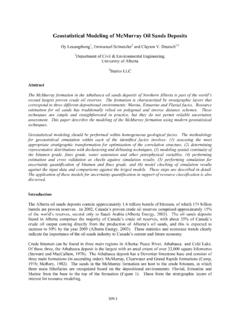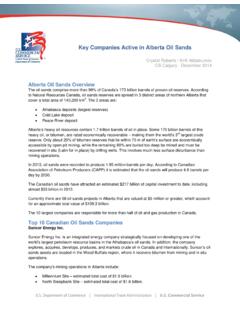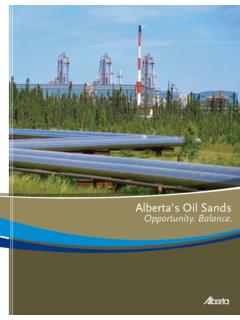Transcription of The Rotational Workforce in the Athabasca Oil Sands Area
1 The Rotational Workforce in the Athabasca Oil Sands AreaRotational Workforce in the AOSA Rotational work is not new to alberta or other provinces within Canada. Given the location, nature and magnitude of oil Sands development, Rotational workers have been, and remain, a constant feature of oil Sands activity in northern alberta . Over the past decade, Rotational workers have grown in number in the Athabasca Oil Sands Area (AOSA) due to industry s major expansion in the early to mid-2000s. Although initially these workers were used to support temporary activities (construction and maintenance), they have been increasingly used in longer-term operational activities, as industry s labour needs increase and development extends away from the service centres.
2 Since the economic downturn in 2015, and as projects have transitioned from construction to operations and maintenance, the Workforce requirement has decreased. In fall 2017, the Oil Sands Community Alliance (OSCA) commissioned Nichols Applied Management (Nichols) to carry out research on the oil Sands Rotational Workforce in the AOSA. The goal was to understand the size and nature of the Workforce as well as to articulate industry s current and anticipated use of Fly-In Fly-Out (FIFO). The last time an in-depth Rotational Workforce survey was done by Nichols was in 2007. The research was specifically targeted at a significant subset of the Rotational Workforce , namely workers engaged in work related to oil Sands operations.
3 The research aims to inform governments, communities, businesses, service providers, camp operators, and others on the nature of Rotational work. WHAT IS A Rotational Workforce ? Although Rotational workers might stay in camp or in Fort McMurray, the one defining characteristic of these workers is that they do not commute home on a daily basis to their permanent workers are not unique to the oil Sands industry . Other sectors such as hospitality, health, and mining also use such arrangements. Rotational arrangements include specific number of days on (at work) and days off (off work) and scheduled daily shifts (day, night or other).
4 1. Fort McMurray International Airport, Economic Impacts Associated with Current Air Services, of Rotational Workforce In the early 2000s, stronger oil prices resulted in a change in the economics of oil Sands development. Between 2000 and 2008, there was a substantial population growth in the Regional Municipality of Wood Buffalo (RMWB) from 51,406 to 103,3342. In 2005 and 2006, the RMWB identified housing as the most significant challenge and that rapid population increase was straining local infrastructure and service levels. The RMWB called for a moratorium on growth and suggested the pace of development in the RMWB be slowed to permit infrastructure growth at a more orderly and carefully planned rate3.
5 In the following years, the RMWB recognized that work camps were an important tool to address chronic housing shortages in the region. industry has invested hundreds of millions of dollars in infrastructure to support a Rotational Workforce , justified by years of planned future operational use. Aerodromes can cost up to $100 million to build while full-service lodge facilities can cost up to $250 has historically been, and continues to be, committed to hiring locally by offering competitive salaries and other incentives to encourage workers to reside in accommodations other than work camps in the area4.
6 Most projects have bus or shuttle trips to Fort McMurray and other communities within the region. Ranging from daily to weekly, these trips transport workers from their homes at the beginning or end of their shift rotations. 2. RMWB, Census 2015, p. 13. 3. (Tetley, D. Star in Star Phoenix Report, 2005 Nov. 5) Managing Growth: Building a Sustainable Development in Fort McMurray, Tracy RMWB, Census 2006, Workers in the AOSAQ uick FactsCurrently, 15 oil Sands projects utilize FIFO for operations. These 15 projects represent roughly 60 per cent of total oil Sands production capacity in the a couple of smaller projects are within commuting distance, the majority of those projects are remote, located outside of a daily sustainable commuting distance for shift workers.
7 One-way door-to-door travel times range between 90 minutes to three hours. Eleven of the 15 oil Sands projects utilize seven private aerodromes. In addition to the private aerodromes, substantial FIFO activity utilizes the Fort McMurray International Airport. A 2017 survey states that 40 per cent of passenger movements through the Fort McMurray airport were Rotational , regularly commuting oil Sands construction, operations and maintenance workers1. Who are the AOSA Rotational Workers?AOSA Rotational Workers Are: The operations-related Rotational Workforce is overwhelmingly male (85%) and mostly married (71%).
8 Approximately 13% of operations-related Rotational workers identified as either First Nation (7%), M tis (5%), or Inuit (1%). Nearly half (47%) of operations-related Rotational workers are over the age of 44. Approximately 5% of respondents live in the AOSA region (mostly in Fort McMurray), and 1% live in Lac La Biche. Just over 60% of operations-related workers come from alberta , excluding the AOSA. Roughly one-third (32%) of respondents are from elsewhere in Canada. Of those Rotational workers whose place of residence is elsewhere in Canada, roughly four in ten (42%) reside in British Columbia.
9 Nearly 60% of operations-related Rotational workers have worked more than 5 years in the region, with over one-quarter (26%) having worked more than 10 years in the total 2,275 surveys were completed either online or in-person at work camp +Years+44 Years60%5+Years+44 Years60%5+Years+44 Years60%5+Years+44 YearsBenefits of a Rotational WorkforceOil Sands companies remain committed to hiring locally and developing the regional labour force, while also using workers from outside the region to effectively staff their operations. However, there are several reasons why a company may choose to use a Rotational The nature, magnitude and remoteness of the oil Sands industry drives the need for a Rotational Workforce .
10 The average driving distance from most operation sites to Fort McMurray is 120 km. Including the time for neighbourhood pick-up and drop-off routes, one-way trips range from a minimum of 90 minutes to more than three hours. This does not factor in morning and evening peak traffic and weather Maintaining worker safety is a key driver for camps. A daily commute by vehicle would add a minimum of three hours onto a 10 or 12-hour workday, introducing performance and safety concerns. Most companies consider the safe daily limit for driving for 12 hour shifts to be 60 minutes per one-way trip. Oil Sands operations on the edge of daily commuting find that many workers consider the fatigue of a 12-hour shift combined with the daily commute unmanageable, and request to be in camp during PERFORMANCE Readiness for work is a key focus for proponents, as it affects productivity and safety.












